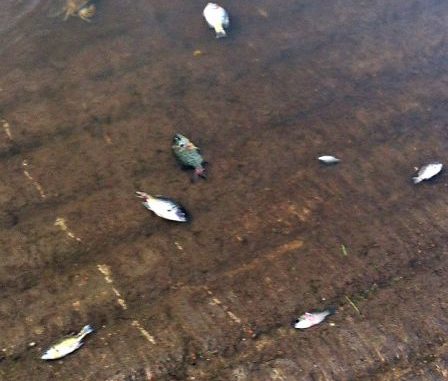
Catfish, bass, crappie, drum turn belly up after Category 1 hurricane, LDWF says.
Massive numbers of fish are desperately gasping for air across Southeast Louisiana, according to reports from fishermen as well as Louisiana Department of Wildlife & Fisheries officials venturing into the inland waterways following last week’s battering by Hurricane Isaac.
Widespread fish kills happen each time the high winds and rains of a hurricane cause the varying cool and warm waters to mix too rapidly and deplete oxygen levels, said LDWF Director of Inland Fisheries Mike Wood.
Wade LeBlanc, who went to check on his camp in Belle River on Monday (Sept. 3), said that initially the water quality looked OK. But with every hour that passed, the water became darker and he started seeing more and more fish, crawfish, crabs, shrimp and eels clamoring to get on the banks and into shallow water. LeBlanc saw catfish, sac-a-lait — “You name it,” he said.
It’s the creatures with gills, Wood said, that are in the most trouble.
On Tuesday (Sept. 4), LeBlanc reported that things continued to get worse. Thousands of baby catfish covered the banks, frantically trying to escape the oxygen-depleted water. As the water level slowly dropped, he said, the numbers of visibly dead and dying fish only increased.
The black water and accompanying stinky, swampy smell continue to get worse. Wood said the “rotten egg” odor and dark color is caused by the decomposition of vegetation.
Farther to the north, inside the Atchafalaya Basin, Marlin More reported seeing a similar scene when we went fishing on Saturday (Sept. 1) in Cross Bayou while he headed toward Murphy Lake.
Once he got into Cross Bayou, More said, the water turned intensely black and the strong sewer-like smell became overwhelming. Many fish were already dead, floating in the water, he said, with many more visibly dying.
Concentrated in about a two-mile stretch, More said he saw hundreds of fish, including garfish, sac-a-laits and bass. The smell was so horrendous, he said, he spent just a few minutes fishing before leaving.
When he went fishing Friday (Aug. 31) in the Grand Lake/ Big Pigeon area, More said, the conditions were fine.
From what he’s heard from other fishermen and read in online reports, LeBlanc said, there are fish dying pretty much all over Southeast Louisiana — anywhere that was in the large, slow-moving hurricane’s path.
According to Wood, the overall regional impact is still under assessment as authorities continue to receive reports of areas where fish kills have been observed.
Thus far, he said, inland fisheries have been affected from St. Martin Parish to St. Charles Parish. In each case, as is to be expected after a major storm, it was the low level of oxygen determined as the cause of the kill.
While it’s an unfortunate scene he’s accustomed to seeing after a hurricane, LeBlanc said he was surprised to see such a delayed response from the storm that passed through a week ago.
“The weather didn’t even get that bad here,” he said of the Belle River area.
From what LeBlanc had seen on Tuesday, it was only beginning.
“It’s getting progressively worse and worse,” he said.
But all things considered, Wood said that so far there hasn’t been anything particularly unusual about Isaac’s aquatic genocide. While it can look like all is lost, Wood said, the good thing is that fisheries have become very resilient and always rebound, though it may take two to three years — assuming there isn’t another hurricane.
Different species have different susceptibility to the depleted oxygen levels, Wood said. Shad and freshwater drum are among the most susceptible, followed by catfish, bass and sunfish.
When you start seeing dead garfish (a species with rudimentary lungs) and choupique, he said, then you know that the oxygen is at a very low level.
After Hurricane Andrew hit in 1992, 200 million fish were killed overnight, Wood said. Two to three years later, “We were back in business.”
In response to Andrew, officials instituted a 14-inch limit for bass in the Atchafalaya Basin. That regulation remains today, though it is the source of some controversy and is being revisited in a current study.
There are always pockets of survivors, Wood said, and as they spawn there will be massive numbers of young fish without as many larger fish to eat them. Wood said that he’s has never seen a total loss, and doesn’t expect to now.
Efforts including restocking have been used in the past, Wood said, and may be used in days to come. But even without restocking, Wood knows that fish populations are “more than capable” of recovering — in time.
Read other updates and post your own observations, photos and vids on the Official Hurricane Isaac forum thread.
Not a member yet? It’s free, so click here to register and get started today!
